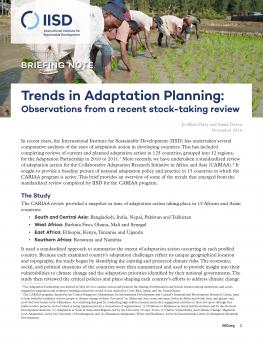
Trends in Adaptation Planning: Observations from a recent stock-taking review
This brief provides an overview of observed trends in adaptation action that emerged from a standardized review of efforts in 15 African and Asian countries.
IISD recently completed a standardized review of adaptation action in 15 African and Asian countries for the Collaborative Adaptation Research Initiative in Africa and Asia (CARIAA).
This brief provides an overview of observed trends in adaptation action by the developing countries surveyed.
Although the countries surveyed in the CARIAA review differ significantly, their priority areas for adaptation were found to be largely consistent, namely agriculture, fresh water and human health. Many countries also prioritized adaptation action in their energy and fisheries sectors, as well as strengthening their disaster risk management capacities.
Countries are integrating climate change into national development plans and, to a lesser extent, sectoral policies and strategies. Most countries have initiated National Adaptation Plan (NAP) processes, while some have completed their plans. Only a few of the countries reviewed have initiated efforts to establish systems to monitor and evaluate progress toward their adaptation goals. Progress is also limited with respect to adaptation planning and mainstreaming at the subnational level. Greater focus is needed on building the capacity of subnational actors, as well as enhancing linkages between national and subnational adaptation processes.
Adaptation-focused programs and projects are under way in all of the surveyed countries, but the degree of activity differs significantly from country to country. Most ongoing programming is focused in the agriculture sector. Many projects also seek to improve the capacity of government to implement adaptation action and to strengthen disaster risk management systems. More limited programming appears to be under way in priority sectors such as health, forestry and fisheries.
Stock-taking exercises such as those completed for the CARIAA program can play a valuable role in supporting efforts to advance adaptation action. However, they have limitations in terms of their capacity to capture the breadth and effectiveness of adaptation actions. These strengths and limitations should be taken into consideration as the objectives and modalities of future stock-taking exercises are determined.
Participating experts
You might also be interested in
Review of Current and Planned Adaptation Action in Bangladesh
Review of Current and Planned Adaptation Action in India
This report summarizes the climate risks and vulnerable sectors in India, while providing an overview of policies and initiatives introduced at the national and sub-national levels to advance the country’s adaptation actions.
Review of Current and Planned Adaptation Action in Nepal
This report summarizes the climate risks and vulnerable sectors in Nepal, providing an overview of policies and initiatives introduced at the national and sub-national levels to advance the country’s adaptation efforts.
Review of Current and Planned Adaptation Action in Pakistan
This report summarizes the climate risks and vulnerable sectors in Pakistan, providing an overview of climate change adaptation policies and initiatives introduced in response at the national and sub-national levels.